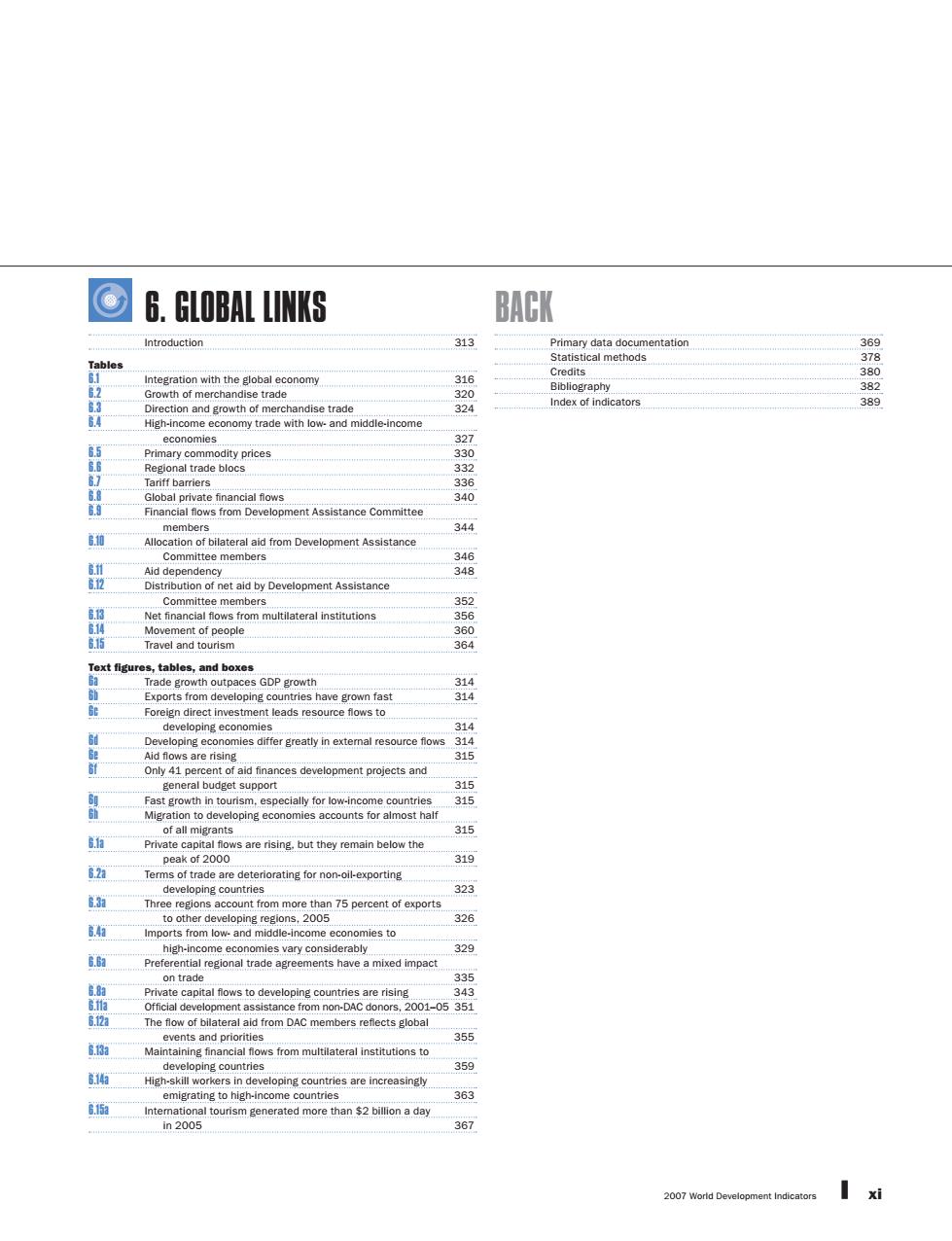正在加载图片...

6.GLOBAL LINKS BACK Introduction 313 Primary data documentation 36g Tables Statistical methods 378 Credits 380 Integration with the global economy 316 2 382 Growth of merchandise trade 320 Bibliography 83 389 Direction and growth of merchandise trade 324 Index of indicators 64 High-income economy trade with low-and middle-income economies 327 65 Primary commodity prices 330 6.6 Regional trade blocs 332 67 Tariff barriers 336 B.8 Global private financial flows 340 B.9 Financial flows from Development Assistance Committee members 344 B10 Allocation of bilateral aid from Development Assistance Committee members 346 行 Aid dependency 348 61° Distribution of net aid by Development Assistance Committee members 352 B.13 Net financial flows from multilateral institutions 356 614 Movement of people 360 615 Travel and tourism 364 Text figures,tables,and boxes Trade growth outpaces GDP growth 314 Exports from developing countries have grown fast 314 Foreign direct investment leads resource flows to developing economies 314 Developing economies differ greatly in external resource flows 314 Aid flows are rising 315 Only 41 percent of aid finances development projects and general budget support 315 Fast growth in tourism,especially for low-income countries 315 Migration to developing economies accounts for almost half of all migrants 315 1间 Private capital flows are rising.but they remain below the peak of 2000 319 B.2a Terms of trade are deteriorating for non-oil-exporting developing countries 323 63a Three regions account from more than 75 percent of exports to other developing regions,2005 326 B.4a Imports from low-and middle-income economies to high-income economies vary considerably 329 B.6a Preferential regional trade agreements have a mixed impact on trade 335 6.8a Private capital flows to developing countries are rising 343 6.f1a Official development assistance from non-DAC donors,2001-05 351 62 The flow of bilateral aid from DAC members reflects global events and priorities 355 613a Maintaining financial flows from multilateral institutions to developing countries 359 614a High-skill workers in developing countries are increasingly emigrating to high-income countries 363 G5面 Intemational tourism generated more than $2 billion a day in2005 367 2007 World Development Indicators xi2007 World Development Indicators xi 6. global links back Introduction 313 Tables 6.1 Integration with the global economy 316 6.2 Growth of merchandise trade 320 6.3 Direction and growth of merchandise trade 324 6.4 High-income economy trade with low- and middle-income economies 327 6.5 Primary commodity prices 330 6.6 Regional trade blocs 332 6.7 Tariff barriers 336 6.8 Global private financial flows 340 6.9 Financial flows from Development Assistance Committee members 344 6.10 Allocation of bilateral aid from Development Assistance Committee members 346 6.11 Aid dependency 348 6.12 Distribution of net aid by Development Assistance Committee members 352 6.13 Net financial flows from multilateral institutions 356 6.14 Movement of people 360 6.15 Travel and tourism 364 Text figures, tables, and boxes 6a Trade growth outpaces GDP growth 314 6b Exports from developing countries have grown fast 314 6c Foreign direct investment leads resource flows to developing economies 314 6d Developing economies differ greatly in external resource flows 314 6e Aid flows are rising 315 6f Only 41 percent of aid finances development projects and general budget support 315 6g Fast growth in tourism, especially for low-income countries 315 6h Migration to developing economies accounts for almost half of all migrants 315 6.1a Private capital flows are rising, but they remain below the peak of 2000 319 6.2a Terms of trade are deteriorating for non-oil-exporting developing countries 323 6.3a Three regions account from more than 75 percent of exports to other developing regions, 2005 326 6.4a Imports from low- and middle-income economies to high-income economies vary considerably 329 6.6a Preferential regional trade agreements have a mixed impact on trade 335 6.8a Private capital flows to developing countries are rising 343 6.11a Official development assistance from non-DAC donors, 2001–05 351 6.12a The flow of bilateral aid from DAC members reflects global events and priorities 355 6.13a Maintaining financial flows from multilateral institutions to developing countries 359 6.14a High-skill workers in developing countries are increasingly emigrating to high-income countries 363 6.15a International tourism generated more than $2 billion a day in 2005 367 Primary data documentation 369 Statistical methods 378 Credits 380 Bibliography 382 Index of indicators 389 WDI07 frontmatter.indd 11 3/25/07 12:17:55 PM